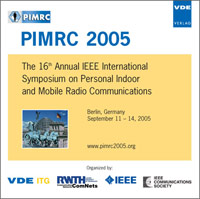Performance of Uplink SS-MC-MA Systems with Frequency Hopping and Channel Estimation Based on Spread Pilots
Konferenz: PIMRC 2005 - 16th Annual IEEE International Symposium on Personal Indoor and Mobile Radio Communications
11.09.2005 - 14.09.2005 in Berlin, Germany
Tagungsband: PIMRC 2005
Seiten: 5Sprache: EnglischTyp: PDF
Persönliche VDE-Mitglieder erhalten auf diesen Artikel 10% Rabatt
Autoren:
Chapalain, Nadine; Mottier, David; Castelain, Damien (Mitsubishi Electric ITE-TCL, 1, Allée de Beaulieu, CS 10806, 35708 Rennes Cedex 7, France)
Inhalt:
To overcome the limitations of uplink air-interfaces where the different user signals propagate through different channels resulting in a high multiple access interference (MAI) at the base station, Spread Spectrum Multi-Carrier Multiple Access (SS-MC-MA) that use Frequency Division Multiple Access (FDMA) for user separation is considered as a good candidate for future cellular systems. It benefits from the diversity gain due to spread spectrum techniques (SS) and high spectral efficiency due to Orthogonal Frequency Division Multiplexing (OFDM). In this paper, SS-MC-MA with two-dimensional spreading and frequency hopping is studied. At first, we optimise the chip-mapping on the user-specific subset of highly correlated subchannels in order to restore a quasi-orthogonality among code multiplexed signals. Beside, we propose a frequency hopping scheme to exploit at the receiving side the frequency diversity of the channel. In addition, we describe a very simple detection and channel estimation technique at the base station using spread pilot symbols. Simulation results in realistic scenarios show that SS-MC-MA is a good candidate for UL communication of future mobile cellular networks.


